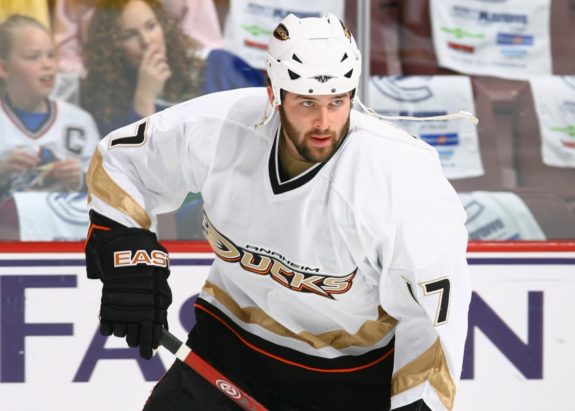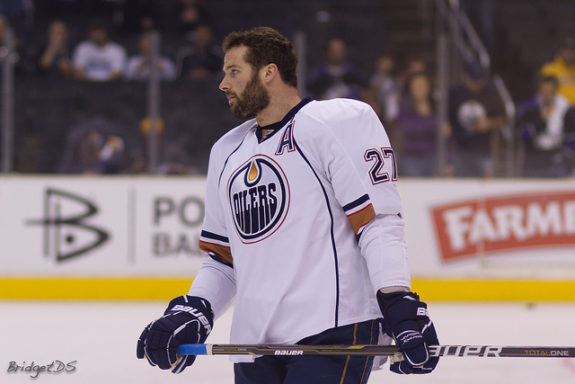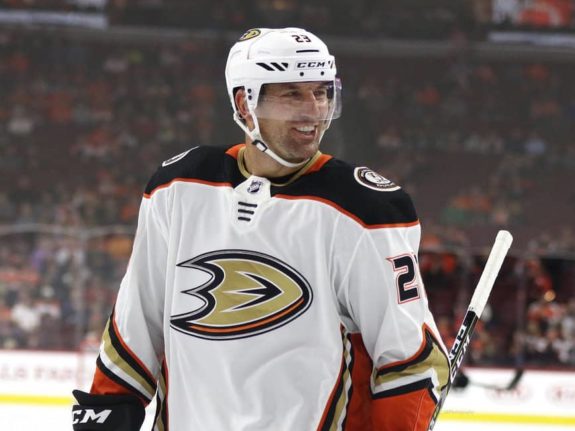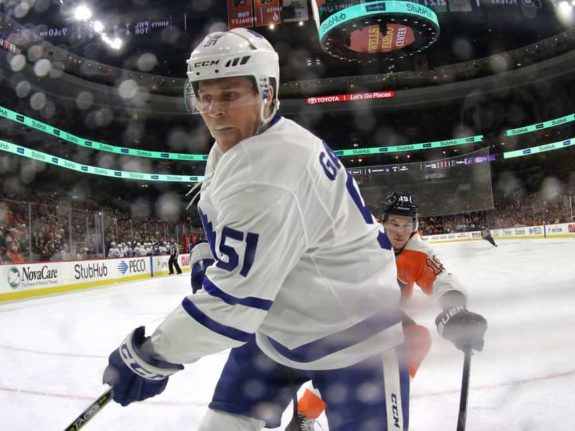The Anaheim Ducks have been around for over a quarter-century. In that time, they’ve jettisoned their fair share of players who became impact players with their new teams. William Karlsson, Chris Kunitz and Shea Theodore are the most obvious choices, but there are three more players who the Ducks moved on from, who, in hindsight, they might have been better served holding onto.
Dustin Penner
This might be hard to admit considering his controversial post-retirement behavior, but Dustin Penner was a big-game player.
Related: Remembering the Anaheim Mighty Ducks’ 2003 Draft
Penner went undiscovered in his amateur hockey career, failing to make any junior team, let alone a major junior team. Instead, he played junior college hockey and broke his femur in his first season before thriving in his second and earning a scholarship to the University of Maine.

Ordinarily, that would be miraculous enough, but it was only the beginning of the road for Penner. Along with future Detroit Red Wings goaltender Jimmy Howard, Penner helped Maine reach the NCAA title game during his only season in Orono.
His performance at Maine earned him a free agent offer with the Ducks, where he continued to defy the odds, making his NHL debut in 2005. Though he played only 19 games for the team that season, his four goals in three assists gave fans a taste of what was to come.
The following season, Penner’s actual rookie campaign, he scored 29 goals and added 16 assists in the regular season, which placed him fifth in voting for the NHL’s rookie of the year award, the Calder Trophy.
He continued his production in the playoffs scoring three goals and notching five assists in the Ducks’ march to the Stanley Cup. That included finishing a feed from Teemu Selanne to score the Game 4 winner, giving the Ducks a commanding 3-1 lead in the series.
Similar to Kunitz, Penner slid in perfectly with the Ducks’ best. His union with Corey Perry and Ryan Getzlaf, known as the “kid line” provided a substantial contribution from players who were only cutting their teeth in the league.
Making History the Wrong Way
After the Ducks won the Stanley Cup, it looked as if Penner would be yet another piece of a core that would make Anaheim a formidable contender to repeat, but Edmonton Oilers general manager Kevin Lowe had other plans.
After Ducks general manager Brian Burke signed 32-year-old free agent Todd Bertuzzi for $4 million per year, the team didn’t have much room left to maneuver to sign Penner, who had entered restricted free agency.
Related: All-Decade NHL Draft – 2010 to 2019
Lowe extended Penner an offer sheet, which was as controversial then as it is now, and Anaheim refused to match a five-year contract offer, worth $4.25 million annually. As a result, Penner became an Oiler. He was the first player to move via restricted free agency since Chris Gratton 10 years prior. He is also the last player to have moved as a restricted free agent since.

Understandably, Burke was furious, and took to the media to voice his displeasure. He fired off several attacks against Lowe in the press, calling the move “an act of desperation.” He then used the compensation returned to the Ducks as ammo for another saying,
“We’re going to take three draft picks back, and given Kevin’s recent performance, I expect them to be excellent picks.”
Penner had robust individual statistics on a bad Edmonton team, including 47 points to Bertuzzi’s 26-point 2007-08 campaign in Anaheim. Considering that Bertuzzi and Penner came with similar annual price tags, and similar playing styles but with eight years difference in age, sacrificing Penner for Bertuzzi, even if the Ducks didn’t expect an offer sheet, was a mistake.
What Could Have Been?
Ducks fans are only left to wonder what the “kid line” would’ve accomplished if they had remained together longer. Watching Penner win his second Stanley Cup title with the rival Los Angeles Kings in 2011-12 only made things worse.
Kyle Palmieri
Kyle Palmieri might be the William Karlsson-lite version of “the one that got away.” The Ducks selected him No. 26 overall in 2009, and after a strong season at the University of Notre Dame, he signed his entry-level contract in August 2010 at the age of 19.
He made his NHL debut just three months later and played 10 games for the Ducks in 2010-11, scoring a single goal. Palmieri spent 2012-13 (after the lockout) and 2013-14 entirely in Anaheim topping out at 31 points in his second full season.
After recovering from an early injury in 2014-15 and then tallying 29 points in 57 games with the Ducks, Palmieri’s time in Anaheim ended via trade. During the 2015 draft, the Ducks sent him to New Jersey for a 2015 second-round pick and a 2016 third-round pick.
Related: NHL Waiver Rules
In the five seasons after leaving Anaheim, Palmieri has only finished below 50 points twice, once in an injury-shortened season and during the 2019-20 season that was suspended due to the Coronavirus pandemic. If the 2019-20 season had gone the distance (there is still a small chance it will,) he would likely have surpassed 50 points yet again.
What Could’ve Been?
This trade is a difficult one to hold against Bob Murray. Palmieri’s numbers more closely resembled Nick Ritchie’s statistics in terms of production from a high draft pick, and his trade freed up some money that helped the Ducks sign Jakob Silfverberg to his 2014-15 bridge deal. Silfverberg has been one of the lone shining lights during the Ducks’ current residency at the bottom of the NHL standings.

Still, if they would’ve kept him, he might have helped prevent their drastic drop in offense.
Jake Gardiner
Of all the players listed in both articles, Jake Gardiner is the only player never to play a game for the Ducks.
Anaheim drafted him No. 17 overall in the 2008 draft, and he could’ve become the first in the line of puck-moving defensemen the Ducks drafted that later included Sami Vatanen, Cam Fowler, Hampus Lindholm, Shea Theodore and Brandon Montour.
After the Ducks selected him, Gardiner improved his game at the University of Wisconsin, scoring 10 goals and adding 31 assists in his final season with the Badgers.
Unfortunately for Anaheim, Murray traded his rights in February of that season to the Toronto Maple Leafs in a package that also included Joffrey Lupul and a conditional fourth-round draft pick in 2013 in order to reacquire Francois Beauchemin.

Gardiner made an impact in his first season with the Maple Leafs scoring 7 goals and adding 23 assists. Following the lockout-shortened 2012-13 season, Gardiner established himself as an offensive threat producing 30 points or more five times in seven seasons.
Beauchemin, who had endeared himself to Ducks fans in his first stint in Anaheim, returned to the team who he’d won a Stanley Cup with and remained there for four full seasons.
What Could’ve Been?
However, although Gardiner and Beauchemin produced similar numbers with their respective teams, Gardiner’s production came with an entry-level contract that cost nearly $3 million less in average annual value than Beauchemin’s deal.

The Ducks were successful during that time and Beauchemin played well, but using the highest possible standards, they still fell short. With the cap savings Gardiner’s entry-level contract would’ve provided along with the trade of Bobby Ryan, would the Ducks have been able to sign or trade for an impact player with a more expensive contract that might have pushed them to another Cup Final appearance? We will never know.
It’s easy to play the role of armchair general manager. Second-guessing the people who chose the rosters of your favorite teams is one of the pastimes of sports fandom. Still, NHL GMs are highly paid because their jobs are hard and they don’t have the benefit of hindsight when choosing who to trade and who to keep, who to sign and who to release. If Brian Burke and Bob Murray had had a crystal ball to see into the future, they likely would’ve found a way to keep these players.